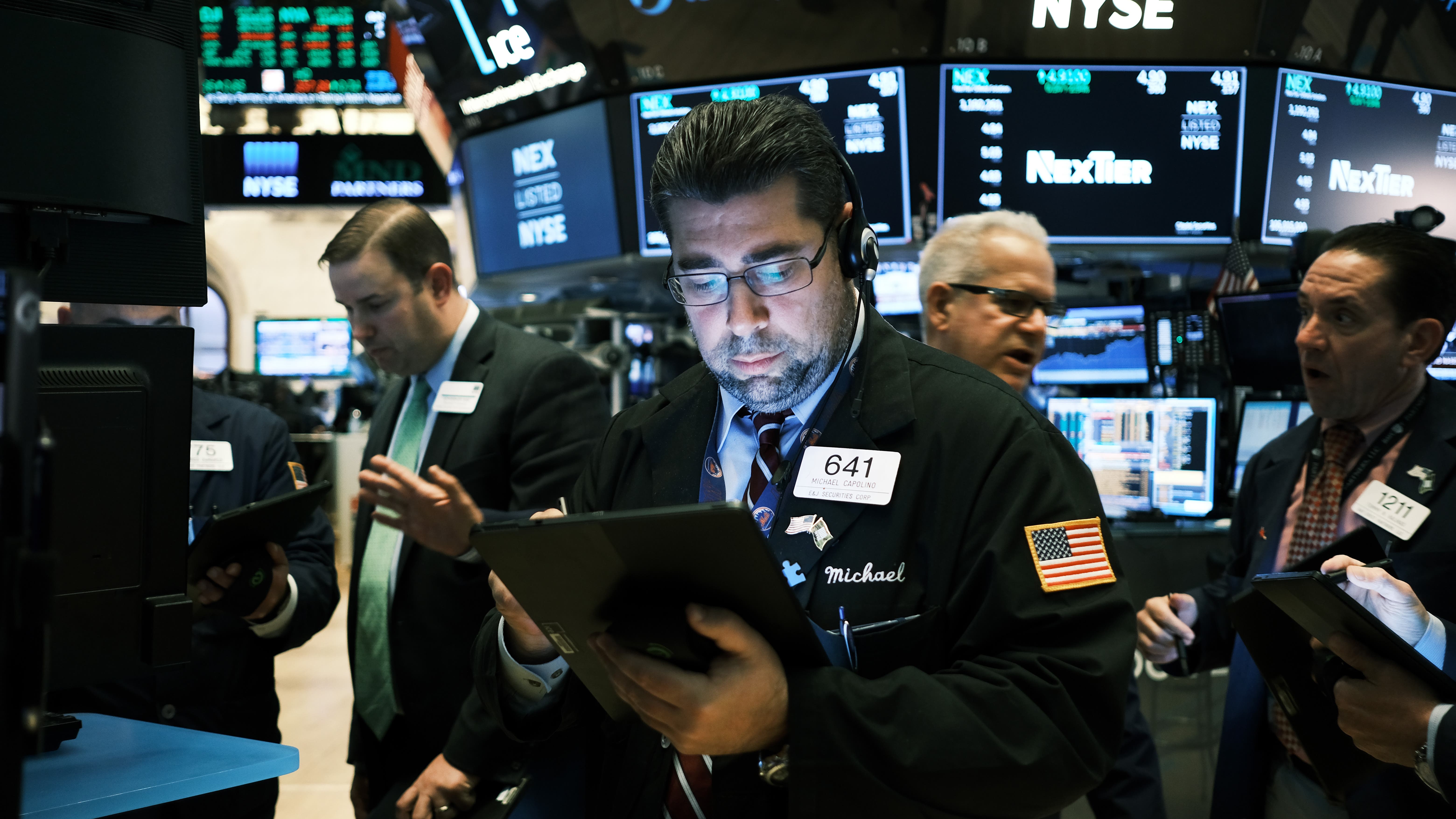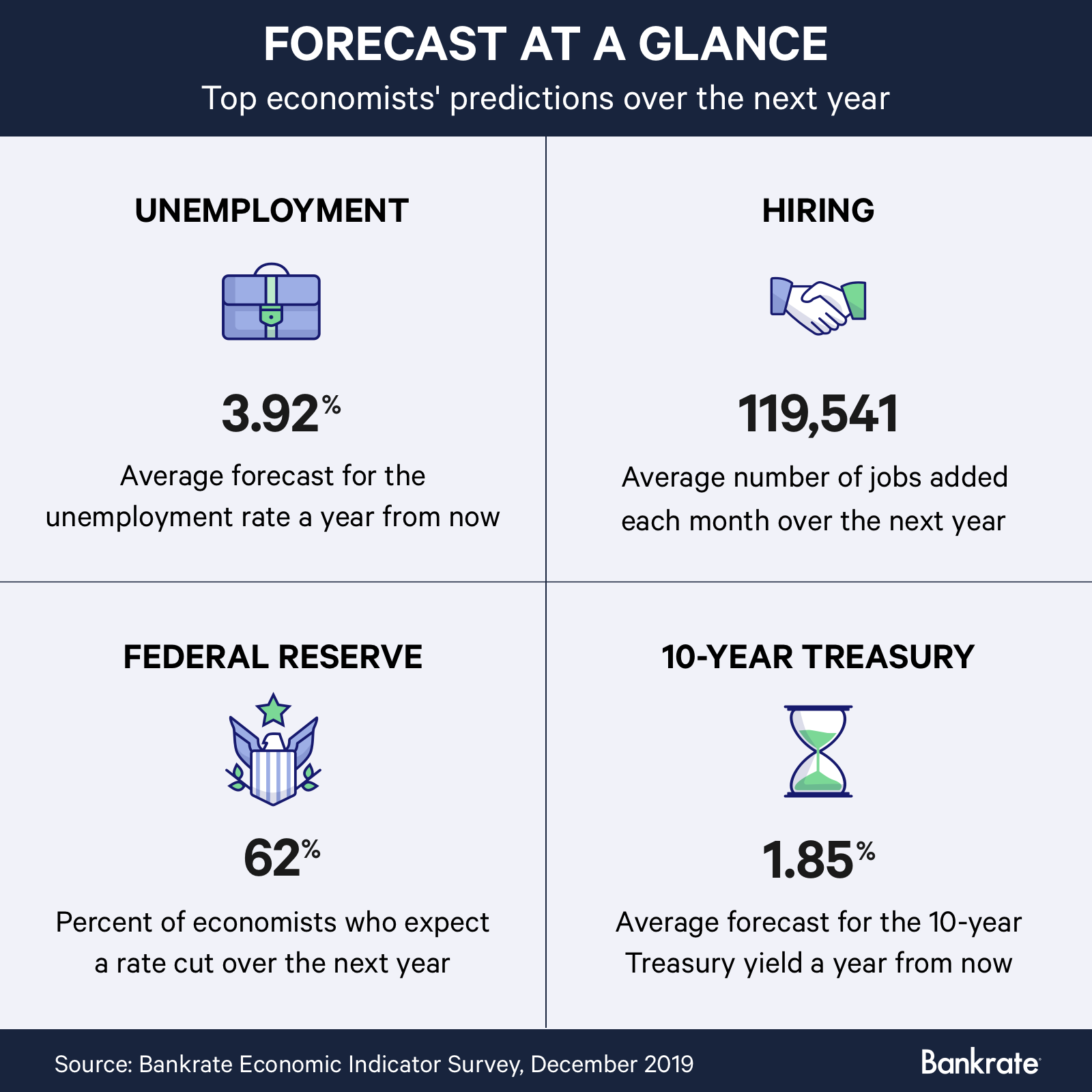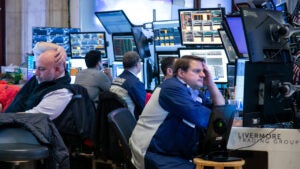Survey: Recession odds diminishing for U.S. economy, but watch for a slowdown

The nation’s top economists say a recession within the next year isn’t probable, but that doesn’t mean the U.S. economy will be worth bragging about.
Experts polled for Bankrate’s Fourth-Quarter Economic Indicator survey estimate a 35 percent chance that the U.S. economy will enter a downturn between now and the November 2020 elections. That’s down from 41 percent during the prior quarter’s survey, showing that experts are more optimistic about the future.
At the same time, however, job growth is expected to slow, the unemployment rate is anticipated to edge higher and the 10-year Treasury yield is estimated to hold near the historic lows seen this year, according to respondents.
Those conditions all reflect the shifting outlook. Recession risks — most prominently caused by the U.S.-China trade war — have moderated somewhat as Beijing and Washington appear to be closing in on an initial “phase one” deal. Meanwhile, the Federal Reserve has propped up the economy with three rate reductions this year.
But the yellow caution tape remains. Manufacturing activity in the U.S. is contracting, and business investment has been negative for two straight quarters. The economic expansion has also naturally lost some steam, given that it’s lasted for more than 10 years.
“Recent central bank easing in the U.S. and abroad along with the incentive for President Trump not to push the trade war to the point where it would incite a recession makes a continuation of the expansion our base case for the next 12 months,” says Sarah House, senior economist at Wells Fargo. “But with global growth still struggling and the late stage of the cycle suggesting the economy has less capacity to absorb a negative shock, on-balance risks remain tilted to the downside.”

What moves will the Fed make in the year ahead?
It’s been a tumultuous year for both the Fed and Fed watchers, with the mixed economic outlook for the year ahead reflected in experts’ divided expectations.
Nearly two-thirds (or 62 percent) of economists expect the Fed to reduce rates at some point over the next 12 months. Nineteen percent of those experts are estimating one cut, while 43 percent expect the Fed to cut two or more times.
That’s fallen off from the prior quarter’s survey. In the third quarter of 2019, 67 percent of economists were forecasting that the Fed would make two or more cuts.
But it’s also contradicting recent Fed communications. After cutting interest rates three times this year, the U.S. central bank signaled in October that current interest rate policy is “likely to remain appropriate, as long as incoming information about the economy remains broadly consistent with our outlook,” Fed Chairman Jerome Powell said during the post-meeting press conference. That means the Fed has a high bar for further cuts.
Bankrate’s survey suggests experts aren’t entirely convinced the Fed’s pause is going to last forever.
“Describing monetary policy as ‘likely appropriate’ given current conditions, Powell acknowledged that further easing would occur only if the Fed were to make a ‘material reassessment’ of its outlook,” says Gregory Daco, chief U.S. economist at Oxford Economics. “Factoring in our sub-potential growth forecast and our expectation for a persistent inflation undershoot of the Fed’s 2 percent target, we believe the central bank will deliver a single rate cut in early 2020.”
Still, 38 percent of experts polled for the survey say the Fed will stay on the sidelines over the next year, refraining from making any rate moves. That’s a finding that no economist had estimated in the prior quarter’s survey, and it lends “credence to the idea that the October Fed cut was a turning point in Fed policy,” according to Greg McBride, CFA, Bankrate’s chief financial analyst.
The Fed’s characterization of policy as being in an “appropriate” place has managed to walk back investors’ expectations of future cuts, at least in the near term, according to CME Group’s FedWatch tool, which tracks federal funds rate futures pricing.
On Oct. 25, just before the Fed delivered its third straight cut, 22 percent of investors also expected a fourth cut in December, while 40 percent estimated a cut in January. As of Dec. 3, however, no investors are estimating a December reduction, while only a modest 12.8 percent are betting on one in January, according to the tool.
Powell also described the Fed’s thinking about when it would be time to hike interest rates again, saying it heavily depends on whether inflation looks to be edging up.
“We’re really not thinking about raising rates right now,” Powell said.
Investors cheered the message, believing it would take a lot for the Fed to hike again. Economists are generally in agreement as well, with no experts in Bankrate’s fourth-quarter survey predicting that the Fed’s next move will be a rate hike.
How are economists viewing the balance of risks?
But even though there’s a growing consensus that the Fed will be on hold, officials still aren’t entirely off the hook, economists point out. Risks to the outlook are still prevalent, and the Fed will be forced to intervene should threats to the outlook materialize.
“The Fed is likely to remain on hold,” says Scott Brown, chief economist at Raymond James. “However, the risks to the 2020 growth outlook are weighted to the downside, and the Fed would act to support growth if necessary.”
Eighty-one percent of experts polled in Bankrate’s fourth quarter survey say risks to the outlook over the next 12 to 18 months are tilted toward the downside. That’s down slightly from 90 percent in the third quarter, but comparable to the 80 percent that felt that way in the second quarter survey and 76 percent from the first quarter.
[READ: Watch for these 6 signs to know when a recession could be coming]
Overall, the economic risks are the same ones that economists have frequently cited: slowing global growth, weak business investment and manufacturing, as well as the erratic U.S.-China trade policy.
“Risks for the U.S. economy in the intermediate term largely depend on outcomes from trade negotiations and the extent of a synchronized global slowdown,” says Odeta Kushi, deputy chief economist at First American Financial.
But more geopolitical risks will be present over the next year, economists noted. The impeachment inquiry into President Trump has caused business uncertainty, as will the upcoming 2020 presidential elections.
There’s the “uncertainty of impeachment proceedings and a trade war, which we do not expect to see resolved before the election,” says Dan North, chief economist at Euler Hermes North America. “Finally, any fiscal stimulus will also be delayed until after the election since Democrats will not want to do anything to support the Trump economy.”
Where will the job market head in the year ahead?
All of these conditions have served as a backdrop for a slowing U.S. job market.
Over the past year, U.S. employers have added an average of 167,000 jobs each month, compared with 221,000 at this time last year, according to data from the Department of Labor.
Economists in Bankrate’s survey see that continuing. Employers are expected to add jobs at an average monthly pace of 119,541 over the next year, down from 125,957.
The range of forecasts has also shifted lower. Experts in this quarter’s survey estimate that average monthly job creation will range between 0 and 165,000, compared with estimates of between 10,000 and 206,000 jobs added each month, during the prior quarter’s survey.
The unemployment rate is also generally seen as moving higher over the next 12 months, with economists estimating an average of 3.93 percent. In October, 3.6 percent of the population was counted as jobless, according to the Labor Department.
Economists caution that it’s too soon to panic just yet. Some slowing was to be expected.
“Though job growth is expected to weaken noticeably in 2020, it will remain slightly above the 100,000 needed to keep the unemployment rate stable,” says Ryan Sweet, director of real-time economics at Moody’s Analytics.
But others say warning signs may already be written on the walls, with recent weak wage growth being one of them.
Economic theory suggests that employers boost pay when the economy is near full employment. Wage growth, however, has fallen in tandem with the unemployment rate. Though joblessness in September fell to an expansion low of 3.5 percent, wage growth on an annual basis rose by 2.9 percent from a year earlier, snapping an almost year-long streak of pay gains that topped 3 percent.
[READ: How is the U.S. economy doing? Here are 5 key signs to watch right now]
In addition, average weekly jobless claims have started to edge up, while firms are starting to reduce hours and capital expenditures. These conditions may spell trouble for the labor market in the year ahead, economists say.
“Given labor shortages, slowing growth and trade uncertainty, there is little reason to think that hiring will do anything but continuously decelerate over the next year,” says Joel Naroff, president of Naroff Economic Advisors.
Where can you expect the 10-year Treasury yield to go?
Estimates for the 10-year Treasury yield in the year ahead were unchanged. Forecasts averaged to 1.85 percent, according to the poll, the same as estimates in the third quarter. It’s also little changed from where Treasury yields are currently trading. At Nov. 14, the start of polling, the 10-year Treasury offered a yield of 1.82 percent.
These findings suggest mortgage rates won’t take off in the year ahead, according to McBride.
“With little change in long-term interest rates expected, this would portend low mortgage rates prevailing in 2020 – a plus for would-be homebuyers or those in the market to refinance existing loans at a rate at or below 4 percent,” McBride says.
But those expectations could be because many economists don’t think growth will take off over the next decade. More than half (or 57 percent) say the next decade will bring the same pace of economic growth, while 33 percent predict the economy will grow at a slower pace. A modest 10 percent forecast a faster pace of economic growth in the next decade, according to the survey.
“Low productivity growth, expectations of rising national debt, and slower population growth all point to a modest growth trend over the next decade, with significant policy headwinds,” says Robert Dietz, senior vice president and chief economist at the National Association of Home Builders.
Consumer takeaways
The U.S. economy looks like it’s going to be walking a fine line over the next year. Growth isn’t blockbuster, but it isn’t slowing at an alarming rate. Job creation isn’t likely to fall off a cliff, but it’s not going to be robust either.
For these reasons, it’s hard to know what the best next step will be. And with interest rates already at historic lows, it’s going to be hard to feel incentivized to save.
But saving is a prudent financial step, and it’s never too early to start building up your emergency savings, according to Bankrate’s McBride. Many savings accounts on the market offer yields 20 times higher than the national average. Shop around for the best rate using Bankrate’s tools, and consider whether locking your cash away in a certificate of deposit (CD) to get a higher rate of return could be the right financial move for you.
“While the odds of recession have eased somewhat in the eyes of the economists polled, it will still be an environment of low interest rates and slow economic growth,” McBride says. “Savers will need to be diligent, not only in squirreling away funds for a rainy day, but also in seeking out the most competitive offers in an otherwise low rate world.”
[READ: 4 ways savers should handle falling interest rates]
As for borrowers carrying a credit card balance, the Fed’s three cuts have already made it an attractive time to start chipping away at debt. Don’t wait around for more Fed cuts before you start to reduce your balance.
“Short-term interest rates may fall further, but consumers with credit card debt shouldn’t wait for that to aggressively reduce their debt,” McBride says. “Low and zero percent balance transfer offers persist, adding a valuable tailwind to debt repayment efforts that a quarter-point Fed rate cut here and there will not.”
Methodology
The Fourth-Quarter 2019 Bankrate Economic Indicator Survey of economists was conducted November 14-21. Survey requests were emailed to economists nationwide, and responses were submitted voluntarily online. Responding were: Scott Anderson, executive vice president and chief economist, Bank of the West; Scott J. Brown, chief economist, Raymond James Financial; Ryan Sweet, director of real-time economics, Moody’s Analytics; Bernard Markstein, president and chief economist, Markstein Advisors; Robert Dietz, chief economist, National Association of Home Builders; John E. Silvia, president, Dynamic Economic Strategy; Gregory Daco, chief U.S. economist, Oxford Economics; Mike Fratantoni, chief economist, Mortgage Bankers Association; Dan North, chief economist, Euler Hermes North America; Yelena Maleyev, associate economist, Grant Thornton LLP; Robert Hughes, senior research fellow, American Institute for Economic Research; Bernard Baumohl, chief global economist, The Economic Outlook Group, LLC; Lawrence Yun, chief economist, National Association of Realtors; Lynn Reaser, chief economist, Point Loma Nazarene University; Joseph Brusuelas, chief economist, RSM; Lindsey Piegza, Ph.D., managing director, Stifel Nicolaus & Co; Sarah House, senior economist, Wells Fargo Securities; Joel L. Naroff, president, Naroff Economic Advisors; Robert A. Brusca, chief economist, FAO Economics; Odeta Kushi, deputy chief economist, First American Financial; Issi Romem, Ph.D, economist & founder, MetroSight; & William Poole, former president of the Federal Reserve Bank of St. Louis.
You may also like

Survey: Odds of a recession by September 2024 fall to 46%





